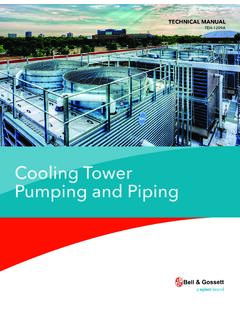Transcription of Side Stream Filtration for Cooling Towers - Energy
1 side Stream Filtration for Cooling TowersPrepared for the Department of Energy Federal Energy Management Program By Pacific Northwest National Laboratory X. Duan, Williamson, McMordie Stoughton and BoydOctober 2012 FEDERAL Energy MANAGEMENT PROGRAM i Contact Will Lintner, PE Federal Energy Management Program Department of Energy 1000 Independence Ave. SW Washington, DC 20585-0121 Phone: ( 202) 586-3120 E-mail: Cover photo: Cooling Towers . Photo from Pacific Northwest National Laboratory ii Acknowledgements The authors of the report would like to thank the following individuals that provided support to the production of the technology evaluation.
2 Elisabeth Giever Rose Zanders Jim Cabe Matt Wilburn Shannon Colson iii Abbreviations and Acronyms ASHRAE American Society of Heating, Refrigerating, and Air Conditioning Engineers BLCC Building Life Cycle Cost FEMP Federal Energy Management Program gpm gallons per minute kW kWh kilowatt kilowatt hour LCC L life-cycle cost liter mm millimeter ORNL Oak Ridge National Laboratory ROI return on investment SNS Spallation Neutron Source TSS total suspended solid iv Contents Executive Summary .. vii 1 Technology Review and Evaluation.
3 1 Background ..1 Technology Characterization ..3 Technology Applications ..5 2 side Stream Filtration System Options .. 7 Centrifugal Separators ..7 Automatic Screen Plastic Disc Filters ..9 Sand Filters ..10 Pressure Sand Filters ..11 High Efficiency Sand Filters ..12 3 System Economics .. 13 4 Evaluate Field Application of Technologies .. 15 5 System Implementation Considerations .. 16 6 References .. 19 v List of Figures Figure Cooling Tower Primary Treatment Concerns.. 2 Figure Cooling Tower with side Stream Filtration 3 Figure Centrifugal Separator Schematic.
4 8 Figure Automatic Screen Filter Schematic.. 9 Figure Plastic Disc Filters.. 10 Figure Pressure Sand Filter Schematic.. 11 Figure High Efficiency Sand Filter Schematic.. 12 vi List of Tables Table side Stream Filtration System Characteristics .. vii Table Relative Size of Common Cooling Water Contaminants (McDonald 2009).. 4 Table side Stream Filtration System Characteristics.. 7 Table Life-Cycle Analysis for Gravity Sand Filtration Systems.* .. 14 Table ORNL Particle Distribution Analysis.
5 15 vii Executive Summary This technology evaluation assesses side Stream Filtration options for Cooling Towers , with an objective to assess key attributes that optimize Energy and water savings along with providing information on specific technology and implementation options. This information can be used to assist Federal sites to determine which options may be most appropriate for their applications. This evaluation provides an overview of the characterization of side Stream Filtration technology, describes typical applications, and details specific types of Filtration technology.
6 Cooling Towers are an integral component of many Cooling systems that provide comfort or process Cooling . Cooling tower systems operation is most efficient when their heat transfer surfaces are clean. However, due to variations in the water source and their operating in an open environment, Cooling Towers are subject to four major water treatment concerns: corrosion, scaling, fouling and microbiological activity. These factors can significantly reduce the efficiency of the Cooling Towers . side Stream Filtration systems can be a cost effective method to address these water concerns through filtering suspended solids out of the Cooling water.
7 side Stream Filtration systems continuously filter a portion of the Cooling water to remove suspended solids, organics, and silt particles, reducing the likelihood of fouling and biological growth, which in turn helps to control other issues in the system such as scaling and corrosion. This results in both water and Energy efficiency gains due to a reduction in the amount of water discharged from the Cooling system and a decrease of scale formation on the heat transfer surfaces. The filter types examined in the technology evaluation are centrifugal separators, automatic screen filters, plastic disc filters, and sand filters.
8 An overview of their main characteristics is summarized in Table and more detailed information on each system type is presented in the main body of the report. Table side Stream Filtration System Characteristics. Filter Type Particle Removal Level Basic Filtering Mechanism Applications Notes Centrifugal Separators 40-75 microns, fine to coarse inorganics with a specific gravity ( ) or greater High velocity water is fed in a circular pattern that moves heavier particles down and out of the system Best for removal of large, heavy particles Minimal maintenance is required Automatic Screen Filter Down to 10 microns Water moves through a rigid screen.
9 Where large particles are trapped and sucked out of the system Best for systems that cannot be interrupted such as industrial processes and hospitals Self cleaning mechanism allows for no interruption in operation Plastic Disc Filter Down to 10 microns Grooved, stacked plates trap particles as water moves through the discs Appropriate where removal of both solids and organics are required Self cleaning mechanism is automatic and requires little down time of the system Sand Filters Down to 10 microns for pressure sand filters.
10 Down to microns for high efficiency sand filters Layers of granulated sand, trap particles as water moves through the sand layers Best for applications that require the removal of fine and low density particles Supplemental chlorine may be needed because sand filters can promote biological growth viii A life-cycle cost analysis was performed on a hypothetical example of a pressure sand filter side Stream Filtration system as part of the technology evaluation. The system characteristics were based on a typical system for a 400 ton chiller with a total installation cost of $45,000 (see Section 3 on System Economics for more details on the example system).











